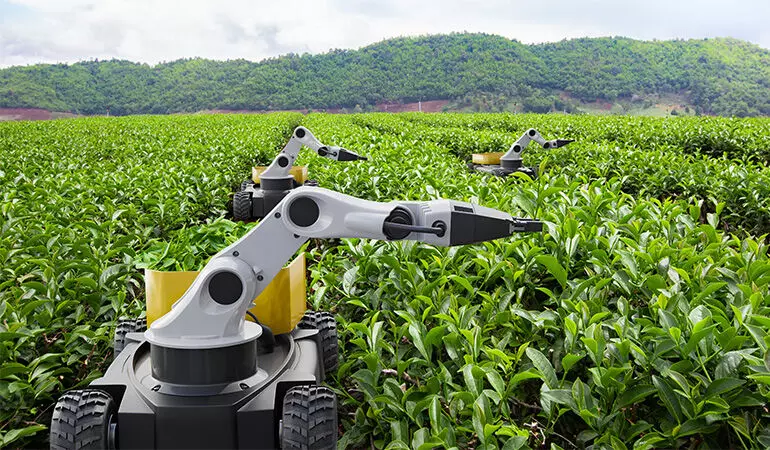Harvesting the future of agriculture with AI

Biswarup Das, a farmer from Purulia, West Bengal, faces many challenges like unpredictable weather, droughts, pests, and low yields. Like many others in India, he struggles with the effects of climate change and poor soil condition. Unfortunately, farmers commit suicide, too, in the country due to financial difficulties and harsh weather.
In a country where a staggering 54.6 percent of the total workforce is engaged in the agricultural and allied sectors, we can very well understand the significance of agriculture to India’s economy. In such a scenario, AI can revolutionise farming practices across the nation. By harnessing data from diverse sources, AI has the power to empower farmers with invaluable insights, enabling them to make informed, data-driven decisions, optimise resource allocation, and mitigate environmental impact. For instance, according to the World Economic Forum, the integration of AI in agriculture holds the promise of a substantial 60% reduction in pesticide usage and a 50% decrease in water consumption.
“The impact of AI on the agriculture sector is profound and continually growing, with a projected compound annual growth rate of 23.1 percent from 2023 to 2028. AI-driven technologies are reshaping traditional farming practices worldwide by addressing various challenges faced by farmers,” said Rahul Paith, CEO of Machine Learning and Artificial Intelligence Technology Hub (MATH).
In India’s growing agritech scene, startups are using AI to help farmers in various ways. One standout example is DeHaat, founded in 2012 by graduates from top institutions like IIT and IIM. Based in Gurgaon, DeHaat offers complete agricultural services to farmers. They use AI to tackle issues like pest control, disease management, and weather forecasting. This helps farmers improve their yields and manage risks better, ultimately making farming more efficient and sustainable.
India relies heavily on agriculture and contributes about 17% to the country’s total GDP and provides jobs for over 60% of the population. Organisations in the agricultural sector are using data to gain detailed insights into every aspect of farming, from individual fields to the entire supply chain. “In order to improve agricultural practices, Indian farmers are increasingly adopting AI technologies. Predictive analytics, which uses AI algorithms to predict optimal planting times and agricultural management strategies based on various data points such as weather patterns, soil health or crop yields, is one of the most significant applications. In order to monitor crop health and identify areas that need attention, AI-powered drones equipped with cameras and sensors are used, enabling farmers to take targeted action more effectively. Machine learning algorithms are helping to detect pests and diagnose diseases so that timely intervention can be made to mitigate losses. In addition, market prediction models based on AI provide farmers with insight into commodity prices and demand fluctuations to make informed choices about crop selection and the sales strategies. Overall, these AI applications allow India’s farmers to optimise productivity, lower input costs and cope better with changes in the agricultural environment,” said Heta Desai Baandal, Managing Director, Sociomark.
India holds the title of being the world’s largest producer of milk, pulses, and jute. In the dairy industry, the health of cattle is paramount as it directly impacts milk output. AI has the potential to significantly contribute to predicting and preventing diseases in both crops and cattle. “AI alerts farmers of anomalies or signs of illness, enabling timely intervention to minimise losses. AI continuously tracks cattle activity, feeding habits, and milk production, facilitating early disease detection. It also automates tasks like milking and feeding, streamlining operations for greater efficiency,” said Tamal Chatterjee, Vice President Marketing, Sid’s Farm, a premium D2C dairy brand.
Meanwhile, addressing agricultural food waste is a pressing concern in India. According to the Ministry of Agriculture, an estimated Rs 50,000 crores worth of food produced is wasted annually. However, emerging technologies have the potential to significantly reduce spoilage and minimize food waste. Advanced technologies such as AI, Internet of Things (IoT), and blockchain are increasingly being employed to track and monitor food supply chains more efficiently. “AI’s ability to predict consumer demand enables farmers and distributors to produce and stock the right amount of food. This proactive approach minimises overproduction, reducing spoilage and waste throughout the supply chain. Also, AI monitors storage and transportation conditions, identifying potential bottlenecks that can lead to spoilage,” said Paith.
Also, AI can significantly help predict and prevent crop diseases and pests. By analysing data on crop health, weather, soil conditions, and pest behavior, AI algorithms can identify early signs of potential threats to crops. “AI systems are capable of analysing vast amounts of data such as past crop disease patterns, weather conditions, soil health and insect behaviour in order to identify possible risks and anticipate outbreaks. Drones equipped with cameras are capable of monitoring fields and capturing images, which can then be analysed by AI algorithms to detect signs of crop damage or pest infestation in real-time,” said Baandal.
While AI is gradually transforming Indian agriculture, several challenges must be addressed for widespread AI integration in the sector. The accessibility and affordability of AI technologies for smallholder farmers, who make up a large portion of India’s agricultural workforce, is a crucial roadblock. “One significant hurdle is the establishment of a robust data infrastructure conducive to AI applications. Farmer education, too, plays a pivotal role in facilitating AI adoption. Also, ensuring the affordability of AI-powered solutions is paramount to enable broader adoption among farmers,” said Chatterjee of Sid’s Farm.



